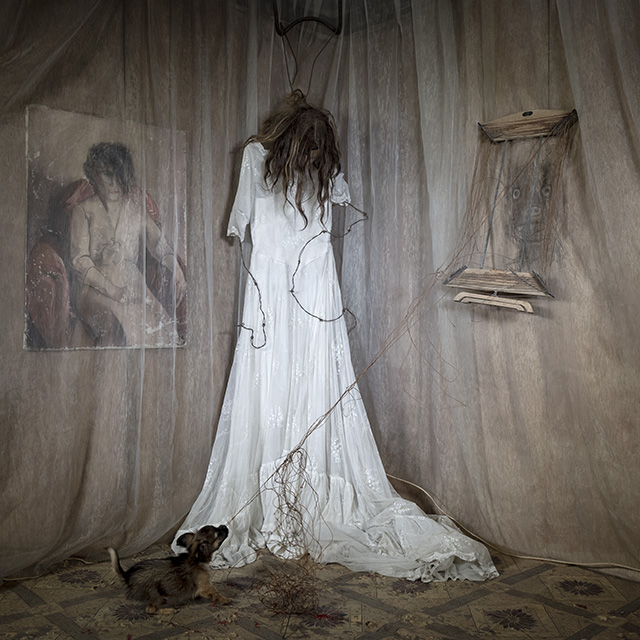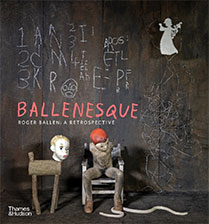Ahead of his talk at the Johannesburg Holocaust and Genocide Centre, photographer Roger Ballen shows me around his new space, which he’s calling the Inside-Out Centre for the Arts. It’s not quite yet open to the general public, but already houses several installations related to the environments he creates in which to stage his photographs.
There are many taxidermy animals, skulls, dolls or dummies, as well as antique guns. One display looks like an old funfair roundabout to which zombie-like figures cling. Another is a replica of a poor dwelling, as patched together from old bits and bobs.
“I’m still doing a lot of photos, but I’ve expanded into installations,” Ballen tells me. Now you can practically step into a Ballen image.
Hanging on the walls are photographs from various stages of Ballen’s career, showing both a remarkable continuity and the evolution of his “look” – the specific look that is now dubbed Ballenesque, also the title of the large retrospective book on his work from Thames & Hudson. The updated second edition (the first appeared five years ago) adds his more recent colour photography, the phantasmagoric humour of his Roger the Rat series, and the paintings he made during lockdown in 2020. It is this large book, which comes with an autobiographical account of his development as a photographer, never mind his work becoming world-famous, that will be presented and discussed at the Holocaust Centre event on Sunday 21 August at noon.
His work starts as a relatively conventional set of images drawn from his youthful travels when, straight out of Berkeley, the adventurous American travelled through East Asia and from Cairo to the Cape by road. (He settled in South Africa in the early 1980s, having become a geologist and found work here.)
His first book, Boyhood (1979), is represented: it shows his adhesion to the principle enunciated by the great photographer Henri Cartier-Bresson, who spoke of “the decisive moment” that emerges from his street photography, in which he captures an “event” that may happen in only a split second, freezing motion and simultaneously crystallizing the composition. A man jumping over a puddle, his legs stretched in an arc, captured in mid-air, is perhaps the most famous example of how Cartier-Bresson’s photography works.
 Ripped, 2020
Ripped, 2020
Ballen’s move from documentary (though always artfully composed) photography into art photography, and photos in which he stages his subjects within a constructed environment, may seem to reject the “decisive moment” seized from a living trajectory, but it’s there. He may put a great deal of work into his environments, after much finding, but they are not really static: they are also stages upon which that split-second moment may emerge.
“You have to have the illusion in photography that you’re looking at an authentic moment,” he says.
“It has to feel like I walked in there and I caught something. If you don’t get that feeling, it doesn’t work as a photograph. It’s just a document. This is a very difficult process, to make an installation and for somebody, somehow or another, to feel it. So in a lot of these pictures you have this middle ground between building something and the spontaneity of the process. I don’t think about what I do before I’m going to do it.”
He points to moments in photos that, he says, “make” the photo – the dog that fell asleep amid sculptures and wall drawings, for instance.
The animals in the photos, and those posed around the gallery in their taxidermic form, remind one of what he says in the book: how he’s looking for the animal in the human and the human in the animal. He often juxtaposes people with animals in the photos, as if to note an enigmatic relationship; his use of dummies and taxidermy places his subjects uneasily on the boundary between being alive and being dead.
They seem to exist in a sort of dream space in which the dead still live, or a realm of the subconscious – a Theatre of Apparitions, as one series is titled. The title of another book, Shadow Chamber, is equally apt. That space, though, also becomes the surface of the image in his photographs of substances on glass, sometimes drawn into and sometimes allowed to produce their own form and texture, arising organically from the materials. This is another kind of “decisive moment”.
“These are all on window glass,” he says. “I use epoxies, glues and other materials, and some work better than others. This particular material cracked when it hit the glass,” he points out in one image, where a spectral human (or monstrous?) visage appears to hover amid the craquelure.
“You can never predict this,” he says. “So the ‘decisive moment’ occurs when the material does something unexpected.”

The book also shows how drawing entered his images, even as the photographed human face began to disappear. He had taken a series of pictures in the home of a poor family, discovering to his surprise that they had decorated their walls with elemental sketches. He began to recreate such environments in the studio, and to draw with his own hand on the walls and backgrounds, or to do so in collaboration with his subjects.
The graphic element of wires against walls, as a sort of accidental drawing, emerges at least as early as his 1980s photos in his collection Dorps, reappearing strongly in Outland in the 2000s. But “the idea of drawing in my photographs”, he writes in Ballenesque, about an image from Outland, “came about as a result of interaction with my subjects, many of whom would regularly draw on the walls of their rooms. I would then place these individuals against their drawings, hoping that a visual relationship would appear. In Man Drawing Chalk Faces, the subject was unaware that his drawings mirrored himself”.
After a certain point, the human face disappears from the images, which get ever closer to abstract paintings. (I remark to him that I think his work is very much about texture, and he agrees – kinda.) “Whenever there’s a human face in the picture, the eye goes first to the face to figure out the picture,” he says. His recent works no longer offer the viewer that focal point, that socialised and humanly interactive way of extracting meaning from the image.
He also began taking pictures in colour: “I did 50 years of black and white, but the last four years it’s all in colour,” he says. When we say colour, though, we’re not talking Matisse’s luscious palette but something closer to Giacometti’s near-monochromatic paintings.
As ever with Ballen’s work, a fresh look at his photographs (and the installations) raises more questions than answers. The images remain suspended between mystery and what you might call interpretablity, perhaps over-reliant on the idea of the subconscious as source and explanation, whereas there may be no explanation at all. How Ballenesque.

Comments are closed.